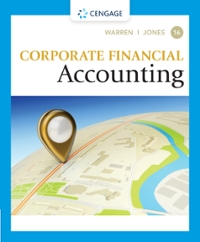Question
Change from FIFO to Average Cost koopmancompany began operations on January 1,2012, and uses the FIFIO inventory method for financial and the average cost inventory
Change from FIFO to Average Cost
koopmancompany began operations on January 1,2012, and uses the FIFIO inventory method for financial and the average cost inventory method for income taxes. At the beginning of 2014, Koopman decided to switch to the average cost inventory method for financial reporting. It had previously reportedthe following financial statement information for 2013:
Income Statement 2013 Retained Earnings Statement 2013
Revenues$100,000 Beginning retained earnings$ 15,000
Cost of goods sold(60,000) Add: Net income10,500
Operating expenses(25,000) Less: Dividends $(6,000)
Income before income taxes15,000Ending retained earnings $ 19,500
Income tax expense(4,500)
Net income $ 10,500
Earning per share$ 1.05
Balance Sheet (12/31/13)
Cash $ 9,000 Account payable $ 3,000
Inventory 38,000 Income tax payable 1,800
OtherAssets 64,100 Deferred tax liability4,800
Common stock, no par 82,000
Retained earnings19,500
$111,100
$111,100
An analysis of the accounting records discloses the following cost of good sold under the FIFO and average cost inventory methods:
FIFO Cost of Good sold Average Cost of Goods sold
2012$50,000 $57,000
201360,000 69,000
2014 70,000 80,000
thereare no indirect effects of the change in inventory method. Revenues for 2014 total $130,000; operating expenses for 2014 total $30,000. Koopman is subject to a 30% income tax rate in all years; it pays the income taxes payable of the current year in the first quarter of the next year. Koopman had 10,000 shares of common stock outstanding during all years; it paid dividends of $1 per share in 2014. At the rend of 2014, Koopman had cash of $10,000, inventory of $24,000, other assets of $70,800, accounts payable of $4,500, and income taxes payable of $6,000.It desires to show financial statements for the current year and the previous year in its 2014 annual report.
1. Prepare the journal entry to reflect the change in methods at the beginning of 2014.
For compound entries, if an amount box does not require an entry, leave it blank.
Retained Earnings
Deferred Tax Liability
Inventory
2. Prepare the comparative income statements
Round EPS to the nearest cent
Koopman Company
Comparative Income statements
ForYears Ended December 31
2014 2013
As Adjusted
Revenues
Cost of good sold
Gross profit
Operating expenses
Income before income taxes
Income tax expense
Net income
Earnings per share
Prepare the comparative retained earnings statements
Koopman Company
Comparative Retained Earnings Statements
For Years Ended December 31
2014 2013
Beginning Unadjusted retained earnings
Less: Adjusted beginning retained earnings
Add: Net income
Less: Dividends
Ending retained earning
Prepare the comparative balance sheets.
Koopman Company
Comparative Balance Sheets
December 31 December 31
2014 2013
Assets
Cash
inventory
Other assets
Total assets
Liabilities and Stockholder's Equity
Account payable
Income taxes payable
Common stock, no par
Retained earnings
Total liabilities and stockholder's equity
Step by Step Solution
There are 3 Steps involved in it
Step: 1

Get Instant Access to Expert-Tailored Solutions
See step-by-step solutions with expert insights and AI powered tools for academic success
Step: 2

Step: 3

Ace Your Homework with AI
Get the answers you need in no time with our AI-driven, step-by-step assistance
Get Started


